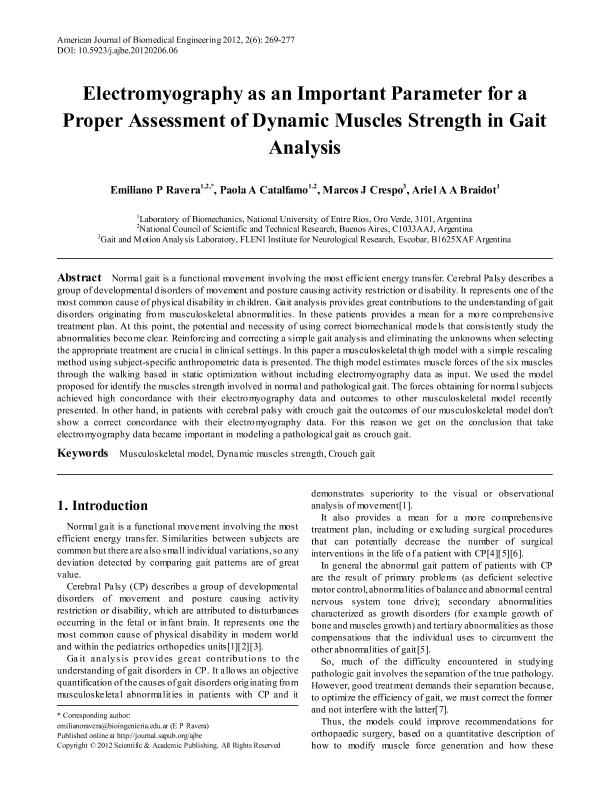Mostrar el registro sencillo del ítem
dc.contributor.author
Ravera, Emiliano Pablo

dc.contributor.author
Catalfamo Formento, Paola Andrea Lucia

dc.contributor.author
Crespo, Marcos Jose

dc.contributor.author
Braidot, Ariel Andrés Antonio

dc.date.available
2023-06-07T19:06:17Z
dc.date.issued
2012-12
dc.identifier.citation
Ravera, Emiliano Pablo; Catalfamo Formento, Paola Andrea Lucia; Crespo, Marcos Jose; Braidot, Ariel Andrés Antonio; Electromyography as an Important Parameter for a Proper Assessment of Dynamic Muscles Strength in Gait Analysis; Scientific & Academic Publishing; American Journal of Biomedical Engineering; 2; 6; 12-2012; 269-277
dc.identifier.issn
2163-1050
dc.identifier.uri
http://hdl.handle.net/11336/199892
dc.description.abstract
Normal gait is a functional movement involving the most efficient energy transfer. Cerebral Palsy describes a group of developmental disorders of movement and posture causing activity restriction or disability. It represents one of the most common cause of physical disability in children. Gait analysis provides great contributions to the understanding of gait disorders originating from musculoskeletal abnormalities. In these patients provides a mean for a more comprehensive treatment plan. At this point, the potential and necessity of using correct biomechanical models that consistently study the abnormalities become clear. Reinforcing and correcting a simple gait analysis and eliminating the unknowns when selecting the appropriate treatment are crucial in clinical settings. In this paper a musculoskeletal thigh model with a simple rescaling method using subject-specific anthropometric data is presented. The thigh model estimates muscle forces of the six muscles through the walking based in static optimization without including electromyography data as input. We used the model proposed for identify the muscles strength involved in normal and pathological gait. The forces obtaining for normal subjects achieved high concordance with their electromyography data and outcomes to other musculoskeletal model recently presented. In other hand, in patients with cerebral palsy with crouch gait the outcomes of our musculoskeletal model don't show a correct concordance with their electromyography data. For this reason we get on the conclusion that take electromyography data became important in modeling a pathological gait as crouch gait.
dc.format
application/pdf
dc.language.iso
eng
dc.publisher
Scientific & Academic Publishing
dc.rights
info:eu-repo/semantics/openAccess
dc.rights.uri
https://creativecommons.org/licenses/by-nc-sa/2.5/ar/
dc.subject
MUSCULOSKELETAL MODEL
dc.subject
DYNAMIC MUSCLES STRENGTH
dc.subject
CROUCH GAIT
dc.subject.classification
Biotecnología relacionada con la Salud

dc.subject.classification
Biotecnología de la Salud

dc.subject.classification
CIENCIAS MÉDICAS Y DE LA SALUD

dc.title
Electromyography as an Important Parameter for a Proper Assessment of Dynamic Muscles Strength in Gait Analysis
dc.type
info:eu-repo/semantics/article
dc.type
info:ar-repo/semantics/artículo
dc.type
info:eu-repo/semantics/publishedVersion
dc.date.updated
2023-06-06T13:24:32Z
dc.journal.volume
2
dc.journal.number
6
dc.journal.pagination
269-277
dc.journal.pais
Estados Unidos

dc.description.fil
Fil: Ravera, Emiliano Pablo. Universidad Nacional de Entre Ríos. Facultad de Ingeniería; Argentina. Consejo Nacional de Investigaciones Científicas y Técnicas; Argentina
dc.description.fil
Fil: Catalfamo Formento, Paola Andrea Lucia. Universidad Nacional de Entre Ríos. Facultad de Ingeniería; Argentina. Consejo Nacional de Investigaciones Científicas y Técnicas; Argentina
dc.description.fil
Fil: Crespo, Marcos Jose. Fundación para la Lucha contra las Enfermedades Neurológicas de la Infancia; Argentina
dc.description.fil
Fil: Braidot, Ariel Andrés Antonio. Consejo Nacional de Investigaciones Científicas y Técnicas; Argentina. Universidad Nacional de Entre Ríos. Facultad de Ingeniería; Argentina
dc.journal.title
American Journal of Biomedical Engineering
dc.relation.alternativeid
info:eu-repo/semantics/altIdentifier/url/http://article.sapub.org/10.5923.j.ajbe.20120206.06.html
dc.relation.alternativeid
info:eu-repo/semantics/altIdentifier/doi/http://dx.doi.org/10.5923/j.ajbe.20120206.06
Archivos asociados
